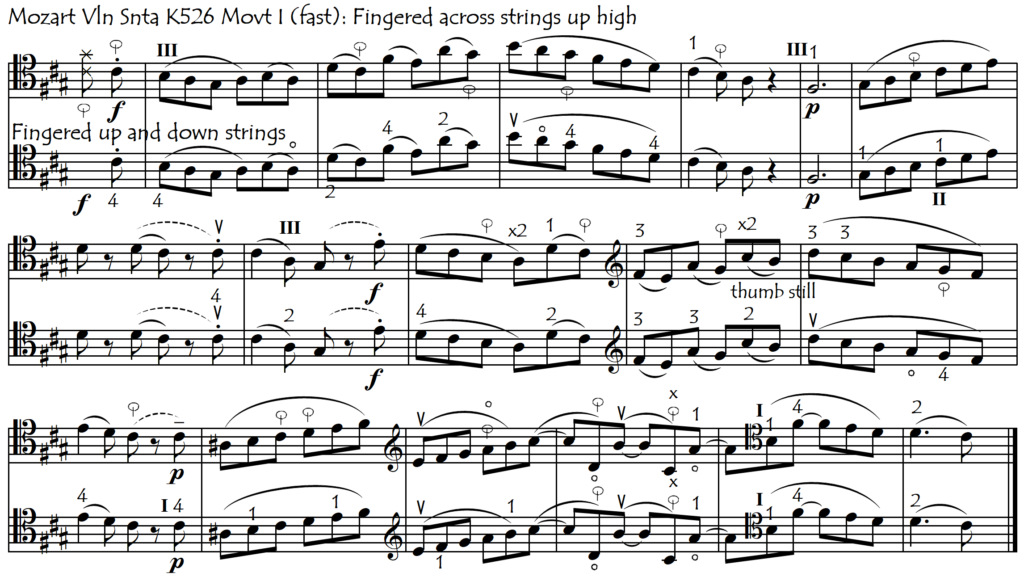Fingering For Thumbposition: Shift Up and Down On Same String or Cross Strings In Same High Position ?
Two main criteria determine how we will finger a passage in (or to) thumbposition: technical (“which fingering is the most secure?”) and stylistic (“which is the most appropriate?”)
The difference in style (aesthetics) between the Romantic Period‘s tendency to swoop and soar, and on the other hand, the Classical Period‘s discretion and “cleanliness” (see Pedagogical Order By Epoch In Thumb Position), has profound fingering implications for the cellist. We can finger passages “Romantically” (staying on the same string) or “Classically” (playing “across” the strings).

In “Classical Style”, this Beethoven example could be played across the strings (as indicated in the suggested fingerings). This “stay- in-one-position” fingering not only makes the passage infinitely easier but also avoids the use of stylistically inappropriate swooping romantic glissandi. Despite the shifting difficulties, most cellists however choose to play it on the A-string for the more soloistic sound quality. But is fingering it all on one string actually so stylistically inappropriate ? This is not “early” Beethoven but rather is his Opus 56, composed in 1803. Mozart has been dead for over 10 years and we are now coming into the Romantic Era, so perhaps the “classical” fingering is already outdated (or almost).
The Tosca theme is, unlike the Beethoven example, a perfect example of a soaring Romantic melody that desperately wants (and needs) not only the big juicy A-string sound but also warm vocal glissandi to accompany the large melodic leaps. Fingering it “across the strings” in such a way as to eliminate these dangerous shifts and dramatic glissandi, as though it were a charming classical-style melody, would make the solo much more secure but would require the use of a lot of the more muted, less soloistic D-string. For these reasons, this solo is almost always played exclusively on the A-string.
But is it possible, for the cellist’s security (and mental health) to find a compromise, keeping the glissandi but still using the D-string ? In the spirit of questioning curiosity, try the following fingering. Each of the last two glissandi is done within the same hand position (the thumb does not move): the third finger contracts towards the first finger before the glissando allowing a portamento of a semitone/wholetone. Surprisingly, even though these are small glissandi intervals, they are sufficient to give the necessary romantic expressive vocal style:

Whereas Beethoven’s music of his mid and later periods is approaching the Romantic Style, Mozart’s music illustrates pure “Classical Style”. How would you finger the beginning of Mozart’s last Violin Sonata K526: up and down the top two strings with loads of shifts, or across the top three strings, starting and staying in thumbposition ?

See also the articles on Technical Fingerings and Thumb Horizontal String Crossings and Glissandi.
The following link opens a compilation of repertoire passages for which we may prefer to start up high on a lower string, already in thumbposition, and cross the strings to go upwards rather than climbing up from the lower regions of a higher string:
Start High And Stay In Same Position Across Strings: REPERTOIRE EXCERPTS
